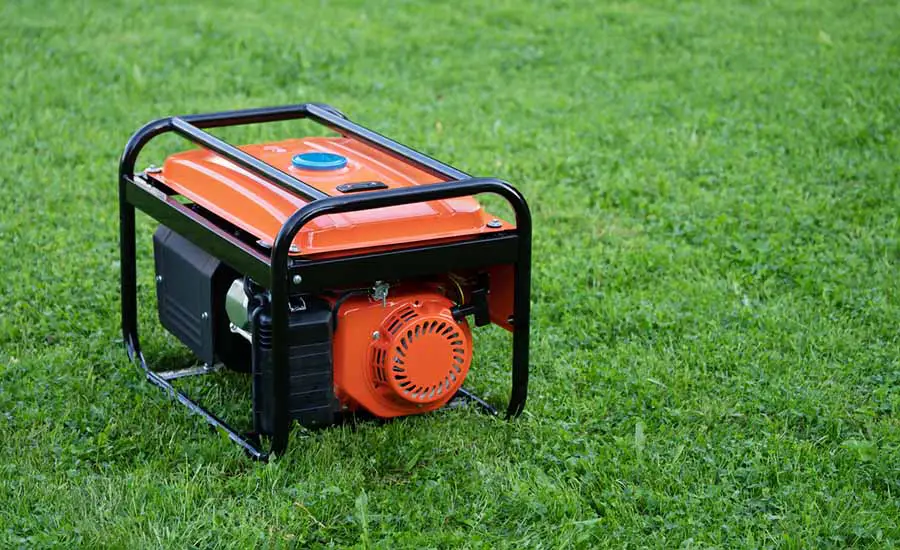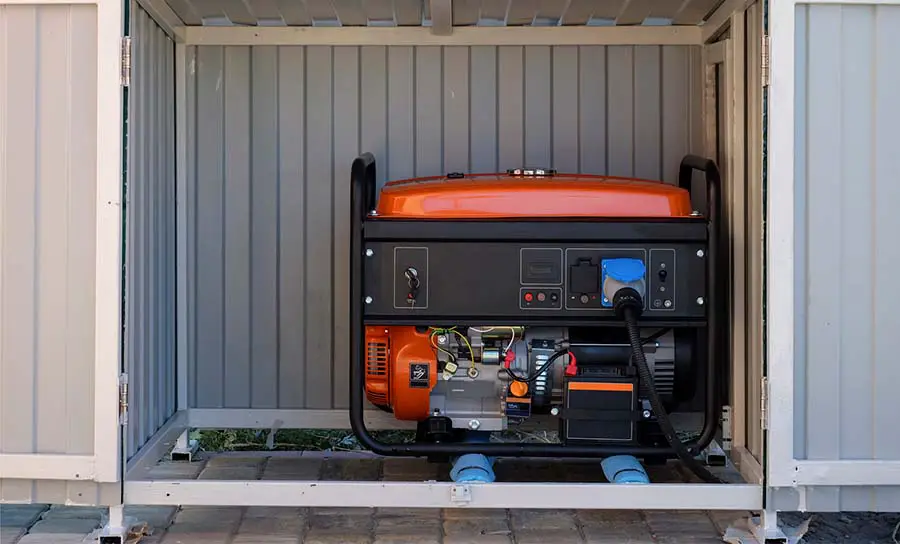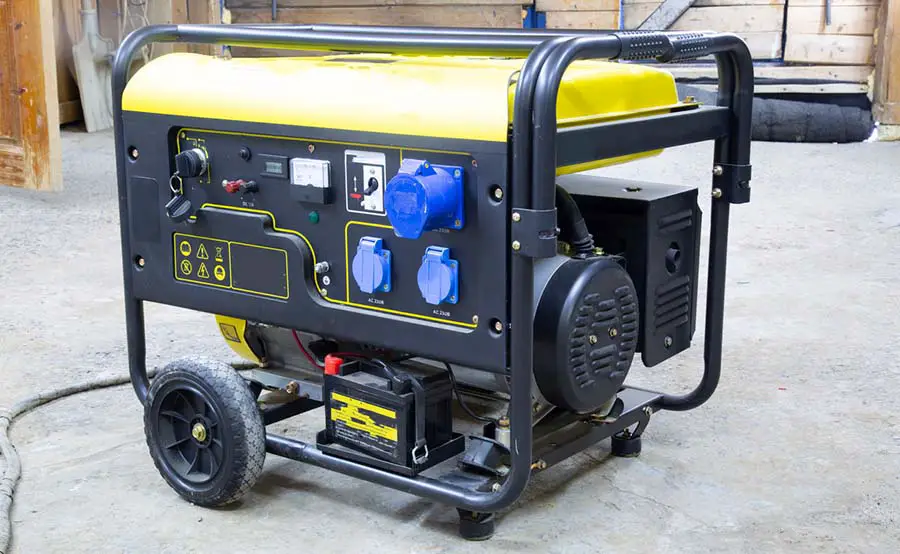
A generator is a lifesaver when there is a power outage. If you have any concerns about the stability of your current electricity source, you should get a generator. However, not many people have the space to store one. So, knowing how to store your generator is equally essential. Here we discuss the ways to keep your generator outside safely.
It is possible to store a generator outdoors safely, but you must protect it from the natural elements using a generator cover or shelter. Leaving your generator outdoors without proper protection can expose it to harsh weather like snow, rain, and wind that can cause severe damage.
This article will detail a step-by-step guide on both the short-term and long-term storage for your generator outside. Let’s find out.
Outdoor Generator Storage Options
There are a few options of generator covers or storage sheds available for generators. You can choose from one commercially made weatherproof tent cover or build a shelter or canopy yourself.
Generator Covers
One option is to cover your generator with a waterproof cover while storing it outside. Commercial generator covers are designed to cover most generators types. They are available with easily assembled frames, and the cover is waterproof heavy-duty material with two zipped panels. The cover has a front panel that rolls up and a side panel for the exhaust outlet and loops in each for pegging it down. It also comes with a waterproof bag for storing it in when not in use.
Generator Shelters
Another option is to build a shelter or shed when you plan to keep your generator outside. The important point is to make sure your shed or shelter is fireproof and has good ventilation. CO poisoning is a real danger when operating a generator in an area where there is poor ventilation.
Also, make sure the exhaust fumes don’t blow towards a neighbor’s house. Your shelter should have a level floor and should be big enough to house the generator. If you don’t know how to build your shelter or shed, some companies can install a generator shelter for you.
Short-Term Generator Storage (Less Than 30 Days)
It is crucial to follow proper storage guidelines to get the best out of your generator. Short-term storage is easy. All you need to do is a basic cleaning and maintenance routine that includes:
- Dusting off your generator
- Cleaning any dirt and debris away
- Removing old grease and grime from the machine
- Inspecting your generator (look for fried wires and loose bolts)
- Filling up your fuel tank after your generator has cooled off
If you use your generator within the next 30 days, you don’t need to do anything extra. Do the essential maintenance necessary after each use, and your generator should run fine.
If you need to store your generator for more than 30 days, then you should read the guide below.
Long-Term Generator Storage (More Than 30 Days)

You should follow this procedure when planning to store your generator for a more extended period, usually more than one month. Although this guide is a bit more complicated, it is not something that a skilled handyperson could not do.
All you need to do to store your generator outside safely is to follow these steps:
- Clean your generator thoroughly by dusting the machine. Clean away any dirt and debris with a soft brush. Remove old grease and grime that have accumulated on the surface with a clean cloth and a degreaser.
- Inspect your generator and look for anything that seems out of the ordinary. Look for loose or frayed wires; corroded, rusty, or damaged parts, loose and missing bolts. Contact a professional service member if anything seems out of the ordinary.
- Drain your fuel tank. You should work in a well-ventilated area. Close the manual fuel shutoff valve. Then use a siphon pump to drain your fuel tank completely. Store your fuel in an appropriate fuel can. Do not forget to close the lid on the fuel tank on your generator after you have drained it. If you don’t want to drain your fuel, you can follow the step below.
- You should add a fuel stabilizer if you are not going to drain the fuel. If you don’t want to run the fuel tank empty, you should add a fuel stabilizer to a full gas tank in the generator. Let the engine run for a minute to distribute the stabilizer throughout the system fully. A fuel stabilizer will help prevent the fuel from absorbing moisture and spoiling in the tank. Fuel stabilizer also prevents the gasoline from eroding plastic and rubber parts in your generator. This way, it will start right up the next time you need it with a full tank of fuel.
- Drain the carburetor. This step is simple. Take your generator outside and start it. Let the generator run until it stops when the fuel runs out. This burns off any remaining fuel that may be left in the fuel lines.
- Add oil into the cylinder. This step should be done before storing your generator for a longer period. Turn off your generator and disconnect the spark plug wire. Remove the spark plug and add around (2-3 teaspoons of new engine oil into the cylinder. After adding the oil, you need to cover that opening with a clean rug that will catch any oil that could spray out. Pull the generator’s recoil starter a few times to distribute the oil around the piston rings and cylinder bore. When this is done, you can reinstall the spark plug and reconnect the wire.
- Store your generator in an outside shelter. If you have done all the above, you can now store your generator in an outside shelter or cover. Store your generator away from any potential source of fire and heat to protect it from elements. While you want your generator on hand, it is not something you will be using all the time. That is why it is important to know how to correctly and safely store your generator outside when it’s not in use so it can be ready to operate the next time you need it.
- Annual Maintenance. Generators are low maintenance items but keeping the outside annual maintenance can go a long way towards their longevity. The two things you need to do annually are to replace the spark plug and replace the air filter. Both tasks are straightforward enough, and the owner’s manual will have instructions.
Note: If you decide to store your generator with the fuel inside your generator, you should top up the fuel tank according to the instructions in your owner’s manual and treat the fuel with a stabilizer to prevent clogging and corrosion.
The main difference between short-term and long-term storage is draining the fuel out of your generator and adding oil into the cylinders. When you plan to store your generator for a more extended period, it’s best to do a complete tune-up of your generator.
Doing these steps will make sure your generator is ready and able to go the time you need it.
Reasons Why You Should Provide Shelter for Your Generator
When storing a generator outside, you must protect it from the elements. Generator storage should be in the form of a sturdy shelter, a durable canopy, shed, or steel enclosure. Listed here are some of the best reasons for providing shelter for your portable generator.
- Protection from the elements: A shelter protects your generator from bad weather conditions like snow, rain, freezing temperatures, and high winds. Harsh weather conditions can ruin your generator and void your warranty.
- Noise: A generator motor humming for hours on end when trying to sleep can be very disturbing. Generators are loud, and they can violate local noise ordinances. A shelter or enclosure muffles the noise and helps keep you and your neighborhood content.
- Wildlife: Having an outside generator enclosure can be particularly important in rural areas; it will keep wildlife away from your generator. Rats and Squirrels can cause damage when gnawing through wires. Nesting birds or wasps can create fire hazards, and who wants to deal with animal droppings?
- Storage space: A generator enclosure will free up space in your outdoor storage shed or garage.
- Security: Make sure your generator is strong and secure from theft.
- Aesthetics: When machinery and tools are standing out in the open, it can be very unsightly. Improve your view by choosing a generator enclosure that is pleasing to the eye and blends in with your surrounding environment.
- Access: An enclosure or shelter provides easy and quick access to your generator in an emergency. You will know exactly where it is located and how to get to it.
Generator Safety Rules to Remember

The following points are important enough to bear repeating. Always remember that when using a portable generator, you should follow these essential safety guidelines.
1. Always Run Your Generator Outdoors
Always use a generator outdoors and away from any structure. You should never use a generator indoors. Generator exhaust fumes give off deadly carbon monoxide. When you start to feel dizzy, sick, or weak when operating your generator, immediately seek medical attention.
2. Disconnect Power Coming Into the Structure
Disconnect the power coming into the structure. When the power is out, this won’t be a problem. But if the power is not out, energy from the generator can go back into the utility lines, creating a hazard for utility workers.
3. Let Your Generator Cool Down
Let your generator cool down entirely before refueling. Adding flammable fuel to a hot generator is not safe.
4. Install a Transfer Switch
You should never plug the generator into a wall outlet. Doing this can be very dangerous. Your generator requires an automatic transfer switch that disconnects the building’s wiring from the utility system. This is a job for a licensed electrician.
What Kind of Surfaces Can You Store Your Generator On Outdoors?
To store your generator outside safely, you can use a couple of surfaces like dirt, grass, gravel, or concrete. The most recommended surface to use is a steel-reinforced concrete pad that offers a secure, level, durable, and watertight base. Other materials are also workable; however, less preferred. Here are some options listed below:
- Direct Contact: The generator enclosure can be set or built directly on grass or dirt. It is important to avoid grassy areas and clear all potentially flammable material under and around the enclosure. Areas, where water can pool should also be avoided.
- Gravel: You can add a layer of gravel that can be spread before building the enclosure on top.
- Concrete Slab: A concrete slab reinforced with steel rebar can be poured and cured before the generator is set atop it and the enclosure is built. This surface is the most preferred and will safely keep your generator away from snow and water that can cause electrocution.
- Patio Blocks: Working with a level, cleared ground space, you can also use patio blocks or pavers blocks to provide a solid base surface outside. These blocks are not as solid as concrete slabs but will provide more stability than direct contact.
Note: Softer surfaces like grass or dirt will dampen generator noise, while harder surfaces like asphalt, concrete, or wood will amplify it. One potential solution to this is to lay a rubber anti-vibration mat on the floor surface of your shelter before placing the generator on it.
Conclusion
Storing your generator outside when you are not using it might seem like a complex process, but it is simple. Generators are a welcome and much-valued piece of equipment when storms or other emergencies cause power outages at your home or business.
Your generator is not always needed, so it is crucial to store it properly for when you need it. Following the tips and solutions discussed above will help extend your generator’s lifespan. When storing a generator outside like any other piece of equipment, it must be stored in a proper shelter or covered to protect wildlife, rain, wind, and snow.

